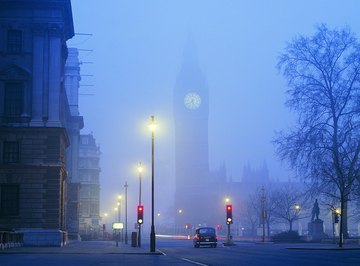
Mercury vapor lamps are the oldest high-intensity discharge lamps in existence, although they are rapidly becoming outmoded by high-pressure sodium, metal halide and fluorescent lamps. Despite their drop in popularity, however, these lamps are one of the most dependable forms of both indoor and outdoor lighting. Some mercury vapor lamps have been known to last for 40 years.
Characteristics and History
Mercury vapor lamps are high-intensity discharge lamps that pre-date modern high-pressure sodium and metal halide lamps. Mercury vapor technology was developed throughout the 1800s in England and Germany. However, the first low-pressure lamps were sold commercially in the United States in 1901 after John Cooper Hewitt innovated the lamp's color spectrum from blue-green to white. In 1935 the modern, high-pressure mercury vapor lamp was developed, which works by electrifying solid mercury, which then vaporizes in a high-pressure tube and produces a bright light between two electrodes. The original lamps were self-ballasted -- meaning they didn't require any external mounting device -- and could be screwed directly into a light socket, although some higher powered lamps use external ballasts: box-like mounting devices that balance and deliver the proper voltage and power to the bulb.
Uses for Mercury Vapor Lamps
Mercury vapor lamps are used primarily in applications where significant lighting power is necessary. They have been used in parking lots and other large-scale outdoor lighting applications, such as city parks and sports venues. They have also been used as ceiling lights in factories, warehouses and gymnasiums. Depending on the application, mercury vapor bulbs are sometimes coated with phosphor for color improvement, or left clear. Mercury vapor bulbs with quartz envelopes have been used in germicidal applications because the bulbs allow ultraviolet light to pass.
Advantages of Mercury Vapor Lamps
Perhaps the main advantage of mercury vapor lamps is their longevity: they commonly last between 24,000 and 175,000 hours. Newer bulbs -- those manufactured after 1980 -- also have a high lumen-to-watt rating, making them more efficient. The white color of the light from mercury vapor lamps can also be seen as an advantage -- according to the Edison Tech Center, as their color rendering is more accurate than that of high-pressure sodium bulbs, which bathe objects in a golden-colored light. However, the advantages of mercury vapor lamps haven't kept them from being phased out by the U.S. Congress.
Disadvantages of Mercury Vapor Lamps
According to the Energy Policy Act that Congress passed in 2005, mercury vapor bulbs and ballasts could no longer be sold as of 2008. This decision was made to phase out mercury vapor lamps in favor of newer, more efficient lighting technology. You are still allowed to use mercury vapor lamps and ballasts, although you can't purchase any replacement parts. However, efficiency and lack of governmental support aren't the only disadvantages to these lights. They contain mercury, which complicates disposal. They also take a considerable amount of time to warm up. Furthermore, while their color rendering might be more appropriate for some uses, they are unsuitable for photography and filmography, which often requires powerful, yet flattering lighting applications.
References
About the Author
Christopher Cascio is a memoirist and holds a Master of Fine Arts in creative writing and literature from Southampton Arts at Stony Brook Southampton, and a Bachelor of Arts in English with an emphasis in the rhetoric of fiction from Pennsylvania State University. His literary work has appeared in "The Southampton Review," "Feathertale," "Kalliope" and "The Rose and Thorn Journal."
Photo Credits
Digital Vision./Photodisc/Getty Images
